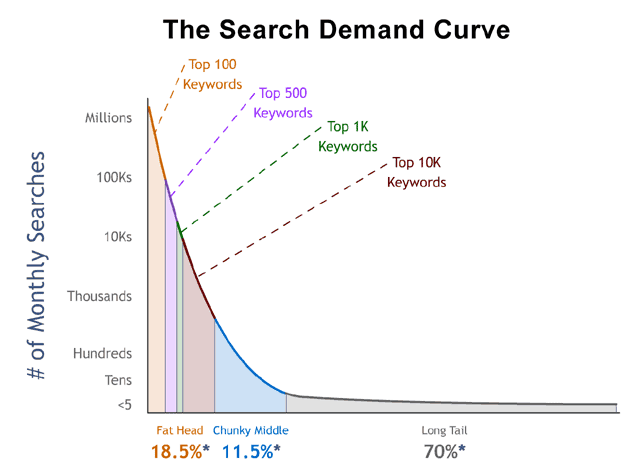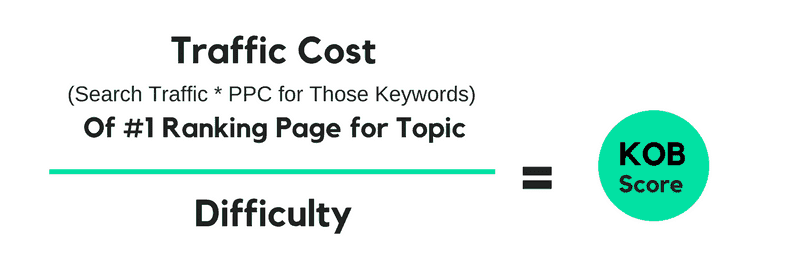When it comes to SEO, we are all looking for the low-hanging fruit. If you are into SEO, then you already know by now that ‘low-hanging fruit’ is a mythical creature. Mythical creatures are not caught they are discovered in the wilderness. Keyword research when done right will enable you to tap the best results with the least amount of effort required.
Keyword Research Best Practices
But which keyword research metrics should you consider? Let’s explore the seven best practices that we believe you should follow for keyword research success.
Search Volume & Ranking Difficulty
Average Monthly Search volume is among the most frequently used metrics for keyword research. Keyword Planner from Google AdWords shows the average monthly searches for any given keyword.
Using an exact match for a keyword gives you a precise representation of the actual volume of searches. To arrive at a more accurate 12-month search volume, it is recommended to segment monthly search volumes and manually average them. Keyword planner doesn’t include search volume for keyword phrases that are auto-corrected. Alternatively, you can also use tools like Moz, SemRush, and Spyfu to arrive at the monthly search volume.
Keywords with higher search volume will attract more traffic but are likely to be more competitive. If you are a brand-new website, then you should target keywords with low search volume to establish domain authority.
Domain authority is a concept termed by Moz. Domain authority evaluates the strength of the website on a logarithmic scale of 0-100. Moz uses over 40 to determine domain authority including site link profile. Your site link profile accounts for both inbound and outbound links. High-quality links are required to develop a strong link profile.
To use search volume efficiently follow the below best practices:
- Choose exact match keyword. If you are skeptical about which exact match keywords to choose from you can conduct a small paid AdWords campaign using keywords set to broad match type to arrive at exact match keywords that could convert for your business.
- If your business is only targeting specific geographies, then choose the appropriate region.
- Manually average the 12-month search volume.
- Group all related keywords that answer the same question together.
Search Demand Curve
The long tail of search demand has existed for many years now. Research conducted by Moz along with Hitwise found that the top 1,000 search terms 10.6% of the overall traffic. Even if you account for the first 1,000 terms, you will still miss out on 89.4% of the total traffic.
Instead of assuming a keyword as ‘long tail’ one has to plot them on a graph based on numerical values to arrive at a structure.
KOB Analysis
KOB Analysis refers to Keyword Objection to Benefit Analysis. KOB analysis helps you to discover best opportunities for conducting an SEO campaign which allows you to allocate resources efficiently.
Difficulty in ranking for a keyword can be calculated with a few factors:
- Age
- Anchor text
- On-page optimization (several subfactors)
- Global link popularity
- Local Set links
- Unique linking domains
- Exact match bonus
- Social signals
For conducting KOB analysis, one could assign scores in a range of 1-10 to each of these areas to arrive at a difficulty score. KOB analysis helps you to arrive at a projection to set a more reasonable expectation.
Relevance
Beyond search volume and KOB analysis, it is essential to check whether your content is relevant to your audience. High organic relevance results in higher CTR and traffic.
To identify relevance, you can use the below tools:
Google Trends
Google Trends provide trends, data, and visualization for any keyword. Google Trends uses time and region to separate the search terms. It also allows you to identify related keywords and queries.
Google Ngram
Google Ngram, unlike Google trends, searches google books database to find keyword and phrases in a corpus of books. For instance, if you were to decide between writing an article on either machine learning or artificial intelligence. A search for the terms in Ngram would have shown a huge spike in interest between 1960 to 2015 for artificial intelligence.
Use Answer The Public to find all the questions that the users are asking for any given keyword or phrase. If you are into creating help content, you can use the tool to identify new opportunities for content creation.
Uber Suggests
Uber Suggests helps you to find new keywords and phrases. You can filter the keywords and also check the relevance using google trends data on the tool.
Easy Wins, Long-Term Wins
A good keyword strategy needs to have a healthy mix of head terms and long-tail keywords. Head terms include generic keywords or phrases that are shorter in length. Head terms are more frequently searched which also makes them more competitive. Long terms keywords tend to be more specific and comprises of phrases which include 3 or more words.
Which of the followings terms will be easier to rank on:
- content marketing
- how to set up a content marketing team
It is obvious that #2 option is easier to rank for. For a brand-new website, it makes sense to target long-tail keywords as it would account for your easy wins. Also, work on head terms in the long haul to find the balance in your strategy.
Keyword Research: The Moving Goal Post
Keyword research is a moving goal post; it is essential to revaluate your keywords every few months. Keep track of your progress in the Google search console and as you start gaining authoring in SERPs keep updating your keyword list to include new keywords & phrases to the list. When it comes to keyword research, there is no proven strategy that works for everyone hence keep exploring until you find something that works for your business.
